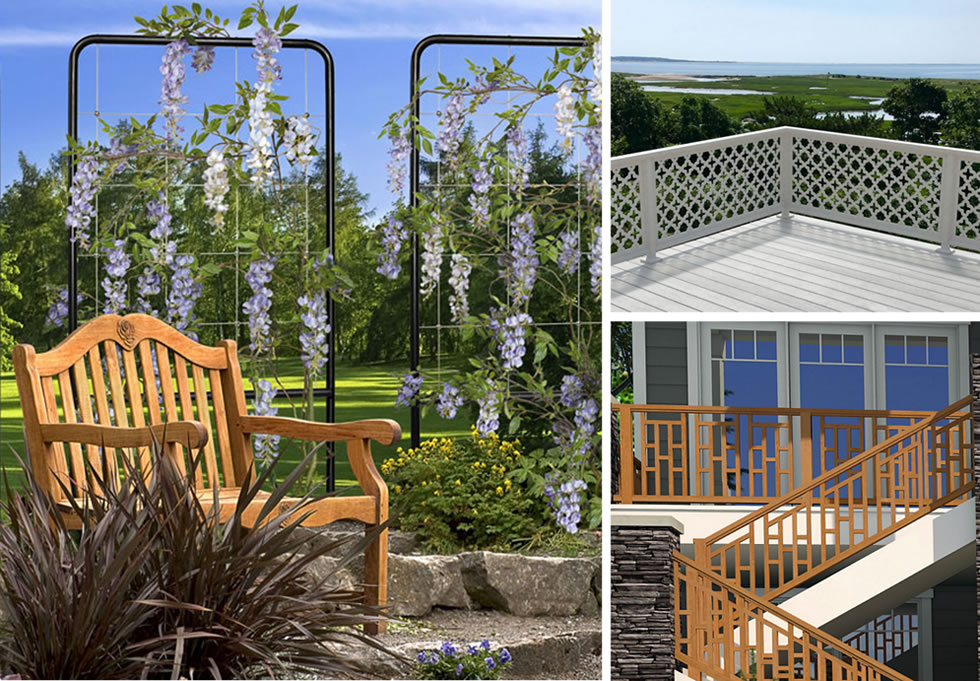
During the past two decades, outdoor living has evolved to become an increasingly important focus for homeowners. Viewing the deck or patio as an extension of their residences, homeowners are using outdoor spaces as additional entertaining areas where they can spend quality time with their friends and family while also connecting with nature. In fact, a 2018 survey from Lightstream reports that 43 percent of homeowners indicated that they were planning to improve their outdoor spaces – with deck, patio and landscaping projects rising to the top of the list.
And, while homeowners want to update their outdoor living environments, few want to spend a lot of time maintaining those spaces. One way to address this concern is to incorporate materials that require minimal upkeep.
Following are some primary ways to make an outdoor space more inviting while keeping the need for maintenance in check.
Deck and porch railings. When it comes to building or remodeling a deck or porch area, railings are not only an important functional element but can also bring added character and style to an outdoor space, helping to personalize and differentiate it. For porches, in particular, adding an attractive railing can significantly increase curb appeal. Fortunately, homeowners can choose from a growing number of railing infill solutions, including several recently introduced options that expand design possibilities while minimizing maintenance.
For example, Fence Quarter offers deck and porch railing inserts that come pre-assembled and ready to be installed into existing posts and rails. Available in architecture-inspired design motifs, the inserts are constructed using weather and pest resistant lumber, and can be delivered pre-primed or pre-painted. They can be installed as a DIY project or by a professional, and are removable for easy cleaning and maintenance, which appeals to busy homeowners who would rather spend their free time relaxing on their deck or porch.
Another option is designer panel infill. DesignRail® Panel Infill from railing solutions provider Feeney comes in a variety of materials and styles, including stainless steel wire mesh and laser cut aluminum panels with powder coated finishes in a range of colors. Both materials are durable and can withstand challenging climates. The panels can be mixed-and-matched with other infill options such as horizontal or vertical cable railing, glass, and pickets to create a custom look.
Outdoor Kitchens. With more homeowners choosing to entertain outside, outdoor kitchens continue to increase in popularity. According to the Freedonia Group, the number of U.S. households with an outdoor kitchen is expected to grow to 3.9 million by 2022. And, the Home Design Trends Survey from the American Institute of Architects reports that outdoor cooking spaces top the list for the most wanted kitchen and bath elements.
To minimize maintenance, many homeowners opt for outdoor kitchens with stainless steel cabinetry, which will stand up to the elements – including challenging coastal environments – over time while requiring only occasional cleaning. Some outdoor kitchen manufacturers offer powder coated finishes in a choice of colors for even more protection and design versatility.
Outdoor kitchen countertops are available in a range of materials, including tile, concrete and natural stones such as granite and soapstone. Natural stone is particularly well suited for outdoor use. Granite is strong and durable, and comes in a wide range of patterns and colors. It isn’t damaged by heat, and – when properly sealed – is resistant to stains, mold and mildew. Similarly, soapstone is heat and stain resistant and only requires periodic treatment with mineral oil to enhance its natural luster.
Landscaping. While landscaping can certainly add impact to an outdoor space, ongoing maintenance is a consideration. Opting to minimize the use of grass and instead add beds of mulch and low maintenance plants such as perennials around the perimeter of a deck or porch area reduces the need for mowing and watering, significantly lowering upkeep. In addition to being inexpensive, mulch helps to prevent weeds and – when it breaks down – fertilizes plants.
Another way to create a low maintenance landscape is to utilize potted plants and container gardens on the deck and patio. Not only do these self-contained greenspaces add color and texture to an outdoor space, but they can be moved around when needed. Larger pots and containers can be placed on rolling stands for easy relocation when the homeowner is hosting a party on the deck or patio. Highlighting native plants will reduce the need for water and help to preserve landscaped areas with minimal effort. Trellises made of wood or stainless steel cable can also be used to showcase flowering vines, optimizing space while bringing a cheerful pop of color to a porch or deck area.
Outdoor spaces are meant to be enjoyed. Investing in ways to minimize maintenance on the front end can pay dividends not only in the short term but also in the long run, by making these spaces welcoming and worry free.
Photos provided by Feeney (left and top right) and Fence Quarter (bottom right)
